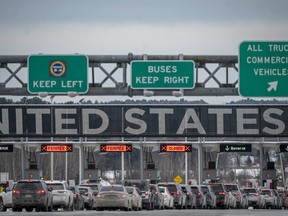The Canadian Armed Forces will not be sent to the Canada-U.S. border, but it will sending more drones to the RCMP and assist with logistics

OTTAWA — The Canadian Armed Forces will not be sent to the Canada-U.S. border, but it will sending more drones to the RCMP and assist with logistics, according to National Defence Minister Bill Blair’s office.
Calls to send the military to the border rang out Monday from Opposition Conservative Leader Pierre Poilievre, who requested Prime Minister Justin Trudeau do so as the clock ticked down to the U.S. imposing 25 per cent tariffs on Canadian imports and 10 per cent on energy resources.
Earlier that day, Mexican President Claudia Sheinbaum announced she and Trump has agreed to a one month delay on the 25 per cent tariffs he planned to slap on Mexican imports after she committed to put 10,000 members from her National Guard at the border,.
A Canada-U.S. trade war was ultimately averted following a second phone call between Trudeau and Trump Monday afternoon, which saw the prime minister announce the U.S. had agreed to delay its tariffs by 30 days.
In exchange, Trudeau announced on X that Canada would continue executing its six-year $1.3-billion border security plan which his government unveiled in late 2024, adding that “nearly 10,000 frontline personnel are and will be working on protecting the border.”
Neither the Prime Minister’s Office nor Public Safety Minister David McGuinty’s office has provided a breakdown of those figures, but the Canada Border Services Agency, which is in charge of official ports of entry, says it has 8,500 front-line employees. The Mounties are responsible for policing between official entry points and several provinces say they have sent local police to help with those efforts, since Trump first threatened to impose 25 per cent tariffs on Canadian goods last November.
Blair’s office said the military would not been involved.
“Canadian Armed Forces (CAF) members will not be deployed to the Canada-United States border,” said spokesman Andrew Green.
He said the Armed Forces “did receive a request from Public Safety Canada” to support by the RCMP’s work at the border with logistics and helping the Mounties’ border task force “with contracting, training and information analysis.”
“The (Armed Forces) also recently transferred 50 drones and will deliver 20 more to the RCMP in the coming weeks as capacity allows,” Green said.
McGuinty, who on Tuesday is spending time in rural Manitoba near the Canada-U.S. border, told CBC News on Monday that Canada is going to have a “much better focus on the border” and irregular border crossings.
He told the broadcaster that would be done through “cameras, Black Hawk (helicopters), drones,” as well as “non-stationary radar and tracking systems.”
While Trump has said he was imposing tariffs on Canada over the flow of migrants and fentanyl into the U.S., Trudeau and other Canadian officials have consistently said that less that one per cent of each entering America comes from Canada.
Nonetheless, Trudeau announced that Canada intends to appoint a “fentanyl czar,” following his second phone call with Trump. He also said his government would launch a “Canada- U.S. joint strike force” and commit to listing cartels as terrorist entities.
Speaking to reporters, Newfoundland and Labrador Premier Andrew Furey said the challenge is going to be “that there is such a small flow of fentanyl, specifically, into the United States from Canada that it will be tough to show the president that there’s been a gigantic reduction because there’s not a gigantic start to begin with.”
With additional reporting from Catherine Levesque
National Post
[email protected]
Our website is the place for the latest breaking news, exclusive scoops, longreads and provocative commentary. Please bookmark nationalpost.com and sign up for our politics newsletter, First Reading, here.